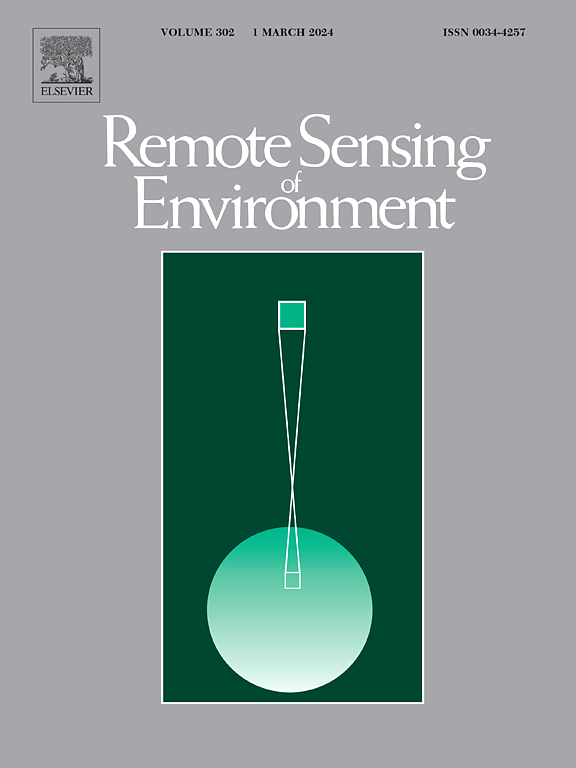Unveiling coastal change across the Arctic with full Landsat collections and data fusion
IF 11.1
1区 地球科学
Q1 ENVIRONMENTAL SCIENCES
引用次数: 0
Abstract
Arctic communities urgently need regional to local-scale information on the rapid coastal changes, caused by thawing permafrost, melting glaciers, and declining sea ice. We introduce a procedure for mapping coastal land cover change from satellite images in the challenging Arctic conditions (and beyond). Our approach utilizes data fusion and cloud computing in Google Earth Engine to process the full Landsat collections for the entire Arctic. It merges information from multiple Landsat sensors and utilizes complementary spatial data and two algorithms to enhance classification accuracy and processing efficiency. This mitigates issues with local illumination conditions and the low availability and quality of satellite data in the Arctic before 2010s. Calculating post-classification composites of coastal land cover over five-year time-steps effectively reduces the impacts of clouds, suspended sediment, and the tide. The procedure was iteratively developed in calibration sites with contrasting physical characteristics. Validation of the final product indicates an overall classification accuracy of more than 98 % (against manually labelled data) and a median shoreline error distance of c. 20 and 10 m in mesotidal and microtidal coasts, respectively. The resulting Arctic Coastal Change dataset presents coastal dynamics from 1984 to 2023 at a 30-m resolution, and highlights hotspots that experience coastal erosion or accretion at a rate of more than 10 m/a. The overall coherence of our results with 61 other studies across the Arctic shows the robustness of the procedure. However, exploring the dataset may uncover localized errors that call for procedure improvements through new collaborative Arctic coastal dynamics studies.

通过完整的陆地卫星收集和数据融合,揭示北极沿岸的变化
北极社区迫切需要关于永久冻土融化、冰川融化和海冰减少造成的沿海快速变化的区域到地方尺度的信息。我们介绍了在具有挑战性的北极条件下(以及其他地区)从卫星图像绘制沿海土地覆盖变化的程序。我们的方法利用谷歌地球引擎中的数据融合和云计算来处理整个北极的全部陆地卫星收集。它融合了来自多个Landsat传感器的信息,利用互补的空间数据和两种算法来提高分类精度和处理效率。这缓解了2010年之前北极地区局部照明条件和卫星数据低可用性和质量的问题。计算5年时间步长的沿海土地覆盖分类后复合数据可以有效降低云、悬浮沉积物和潮汐的影响。该程序在具有对比物理特性的校准地点迭代开发。最终产品的验证表明,总体分类精度超过98%(相对于人工标记的数据),中潮和微潮海岸的中位海岸线误差距离分别为0.20和10米。由此产生的北极海岸变化数据集以30米分辨率呈现了1984年至2023年的海岸动态,并突出显示了经历海岸侵蚀或以超过10米/年的速度增加的热点地区。我们的结果与北极地区其他61项研究的总体一致性表明了该程序的稳健性。然而,探索数据集可能会发现局部错误,需要通过新的协作北极海岸动力学研究来改进程序。
本文章由计算机程序翻译,如有差异,请以英文原文为准。
求助全文
约1分钟内获得全文
求助全文
来源期刊

Remote Sensing of Environment
环境科学-成像科学与照相技术
CiteScore
25.10
自引率
8.90%
发文量
455
审稿时长
53 days
期刊介绍:
Remote Sensing of Environment (RSE) serves the Earth observation community by disseminating results on the theory, science, applications, and technology that contribute to advancing the field of remote sensing. With a thoroughly interdisciplinary approach, RSE encompasses terrestrial, oceanic, and atmospheric sensing.
The journal emphasizes biophysical and quantitative approaches to remote sensing at local to global scales, covering a diverse range of applications and techniques.
RSE serves as a vital platform for the exchange of knowledge and advancements in the dynamic field of remote sensing.
 求助内容:
求助内容: 应助结果提醒方式:
应助结果提醒方式:


